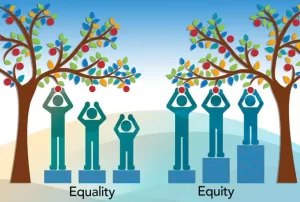The anxiety of learning English as a second language, and the challenges non-English speakers face
I said, “Do you speak-a my language?”
He just smiled and gave me a Vegemite sandwich
Triggered by unfamiliar sounds, different cultural expressions, and fear of making mistakes, have you ever felt that rush of nerves when speaking in English? You’re not alone. Recent studies show over 30% of international students experience foreign language anxiety.
Foreign language anxiety (FLA), is defined as a feeling of apprehension or fear associated with communicating in a foreign language.
Learning English as a second language is undoubtedly tough, especially for international students who are already facing the challenges of living and studying in a new country. FLA can manifest in a variety of ways, such as nervousness, self-doubt, and avoidance of speaking or writing in the new language.
It can have a significant impact on language learning, making it difficult to focus, absorb information, and perform well in class and on assignments.
However, there are a number of things that international students can do to manage Foreign Language Anxiety and improve their language learning experience.
Exploring the Depths of Foreign Language Anxiety
Foreign language anxiety refers to the fear, nervousness, or uneasiness experienced by individuals when using or learning a foreign language. It can stem from a variety of factors, such as the fear of making mistakes, being judged by others, or feeling like an outsider due to communication difficulties. These anxieties can have a profound effect on the learning experience and overall language proficiency.
If you’re an international student, you likely experience anxiety when speaking English. According to research, over 25% of university students in Australia are international, with the largest groups coming from China, India, and other Asian countries.
While the classroom provides some structure, outside interactions can be unpredictable, making it hard to convey what you really mean or understand what’s going on. This anxiety often continues even after graduating as you enter the workforce.
Many hope to gain permanent residency, but to do so, you must meet English language requirements. This could add to the pressure of learning an entirely different language in an entirely different environment from where you grew up.
Unmasking the Culprit: Common Triggers of Language Anxiety
According to studies, anxiety from learning a foreign language can have damaging effects and impact your ability to master the new language. A 2006 study by Lindy Woodrow found that for some students, the anxiety experienced when speaking English was debilitating.
 As an international student in Australia, the thought of speaking English in social situations can trigger feelings of anxiety and stress. Common triggers include:
As an international student in Australia, the thought of speaking English in social situations can trigger feelings of anxiety and stress. Common triggers include:
Speaking with native English speakers. Whether it’s chatting with your professor or ordering coffee, conversing with native speakers when English isn’t your first language can be nerve-wracking. You may worry about misunderstandings, not being able to express yourself clearly, or saying something incorrectly.
Presenting or speaking up in group settings. Having to present in front of classmates or speak up during a team meeting when you’re still learning the language can be anxiety-provoking. Fear of judgment from others, difficulty articulating your thoughts, or general discomfort being the center of attention are all contributing factors.
The Influence of Foreign Language Anxiety on the Learning Journey
Learning a new language can be an exciting and rewarding journey, but it can also come with its fair share of challenges.
For international students, foreign language anxiety can be particularly challenging. Being in a foreign country, away from their native language and familiar culture, can intensify their anxieties. These students may struggle with adapting to a different learning environment, understanding cultural subtleties, and forming connections.
The anxiety often stems from three main factors:
- Difficulty navigating unpredictable social and workplace situations where English is required
- Struggling to convey their meaning due to limited language skills
- Feeling anxious when speaking in group settings or to native English speakers because of fear of being judged.
Their anxiety can hinder their ability to fully engage in classroom activities, participate in discussions, and ask questions, ultimately affecting their language learning progress.
Some specific ways in which foreign language anxiety can affect learning are:
Cognitive impairment: Anxiety when learning English as a second language can interfere with cognitive processes such as attention, memory, and problem-solving. This can make it difficult for learners to acquire new language knowledge and skills.
Communication avoidance: Learners with FLA may avoid speaking and writing in a foreign language for fear of making mistakes or being judged negatively. This can limit their opportunities to practice and improve their language skills.
Reduced motivation: Language learning anxiety can lead to a loss of motivation to learn a foreign language. International students learning English may feel discouraged and give up if they feel anxious and stressed about learning.
Students who experience high levels of FLA are more likely to have poorer grades and lower overall proficiency in the foreign language.
Here are some examples of how anxiety cripples effective language learning:
- A student who is anxious about speaking in a foreign language may be less likely to participate in class discussions or activities. This can lead to missed opportunities to practice and improve their speaking skills.
- International students who are anxious about learning English and are conscious about making mistakes may be afraid to ask questions or volunteer to answer them in class. This can make it difficult to learn from their mistakes and improve their understanding of the material.
- An anxious student being evaluated may avoid taking risks in their foreign language learning. This can make it difficult to develop fluency and confidence in the language.
By understanding the factors that contribute to foreign language anxiety, we can take the steps to minimize them. Students will then have a better chance of overcoming their fears, mastering English, and adapting to their new cultural surroundings. Reducing anxiety and improving confidence in using English will empower international students to fully participate in Australian society.
In professional circumstances there are many great communication solutions available which can be used to improve engagement with your non-native speakers, and address the inherent deficit in their ability to access your services.
A 2006 paper delivered by Lindy Woodrow (Honorary Senior Lecturer in TESOL¹, University of Sydney) details the results from her study about foreign language anxiety. Woodrow looked at students in their final months of studying English, prior to enrolling in university courses in Australia. The study revealed that learning English as a second language can be a negative and potentially damaging experience both in and out of the classroom (Woodrow, 2006). This may impact a learner’s capacity to master their new language and achieve confidence in handling day-to-day communications.
¹Teaching English to Speakers of Other Languages
“Anxiety experienced in communication in English can be debilitating”
Lindy Woodrow
Strategies to Tame Foreign Language Jitters In Classroom
As an international student learning English in Australia, feeling some anxiety in the classroom is completely understandable.
Managing foreign language anxiety in the classroom can be challenging, but there are effective strategies that can help both students and teachers cope with this common issue and here are some of them:
- Identify your triggers. What are the specific situations that cause you anxiety? Once you identify your triggers, you can start developing coping mechanisms.
- Practice your presentation beforehand. Repeating your presentation out loud, ideally to another person, will boost your confidence for the actual presentation. Hearing yourself speak the words will make you more comfortable with the material.
- Focus on your message, not perfection. Don’t aim to speak perfect English without any mistakes. Focus instead on conveying your key message or main points. Your proficiency will improve over time, so avoid being too self-critical.
- Build rapport with your teacher and classmates. Having a good relationship with your teacher and fellow students will make you feel more at ease speaking in class. Try introducing yourself, smiling, making eye contact and engaging in casual conversations before and after class.
- Ask questions. Don’t stay silent if you have a question about an assignment, discussion topic or presentation. Asking questions will clarify any confusion you have and allow you to participate more fully and confidently. Your teacher and classmates will appreciate your questions too.
- Take breaks. When anxiety arises, step back. Shake things up by moving around or doing something you enjoy.
- Reward yourself. When you achieve a language learning goal, reward yourself. This will help you stay motivated and boost your confidence.
The classroom is a perfect place to strengthen your English speaking skills in a supportive environment. Focus on preparation, building connections and self-care strategies to help overcome feelings of anxiety. The more you practice speaking, the more your confidence will grow. With time and experience, interacting in English will feel second nature.
Building Confidence Speaking English Beyond Classroom
Building confidence in speaking English outside the classroom is essential for language learners aiming to enhance their communication skills.
Practicing speaking English in real-world situations will help you improve your fluency, pronunciation, and grammar. Immersing yourself in these situations will help boost your confidence in your ability to communicate in English over time.
Practice Makes Perfect
The more you speak English, the more comfortable you’ll feel. Strike up casual conversations with classmates, neighbors, or coworkers. Ask open-ended questions to keep the discussion going. Join local social or interest groups to meet new people and get used to conversing comfortably. Don’t be afraid to make mistakes – focus on listening, understanding and being understood. With regular practice, your anxiety will subside.
Start Small and Build Up
Don’t throw yourself into anxiety-inducing situations right away. Start with low-key interactions like ordering coffee or asking for directions, then work your way up to lengthier conversations. Give presentations in front of friends or family before larger groups. Take opportunities to speak up at work in meetings or with colleagues. Each experience will increase your self-assurance for the next one.
Focus on Your Message
When speaking in public or to native English speakers, focus on the message you want to convey rather than your language ability. Prepare thoroughly and know your material inside and out. Connect with your audience by making eye contact and speaking clearly. Their reactions or judgment of your English are secondary to communicating your key points. Staying focused on your goal will boost your confidence from within.
Learn Cultural Cues
Familiarize yourself with Australian English expressions, customs and body language. The more you understand the cultural context, the more comfortable you’ll feel interacting with native speakers. Watch TV shows, read books, newspapers and magazines to pick up common phrases and sayings. Knowing what to expect in various situations will ease anxiety and allow your personality to shine through.
Record Yourself Speaking English
This is a valuable tool for tracking your progress and pinpointing areas for improvement. It can also be helpful to listen back to your recordings and get feedback from a native speaker or teacher.
So don’t be afraid to put yourself in anxiety-inducing scenarios – each experience will decrease your stress and increase your self-assurance. You’ve got this, mate! Keep at it and before you know it, chatting with native English speakers will feel as natural as a bunnings sausage sizzle.
The Role of Educators and Schools in Easing The Grip of Anxiety
In tackling the issue of lowering anxiety related to learning a foreign language, it is critical to acknowledge the pivotal roles that educators and educational institutions play in this regard. Teachers provide pupils with safe, supportive environments in which to explore learning a new language.
With international student populations increasing, it’s crucial for teachers and schools to consider cultural sensitivities and find ways to alleviate anxiety.
Providing Emotional Support
- Be aware of the signs of Foreign Language Anxiety. Signs can include sweating, trembling, blushing, and difficulty concentrating. If you see any of these signs in your students, be sure to offer them support and encouragement.
- Reassure students that feeling anxious is normal and help them develop coping strategies. Let them know you understand what they’re going through.
- Encourage students to use self-calming techniques like deep breathing, visualization, and positive self-talk. These can help students gain confidence in their abilities.
Promoting an Inclusive Learning Environment
- Foster an open, welcoming classroom environment where students feel comfortable participating without fear of embarrassment. Call on students to answer questions or speak voluntarily instead of demanding responses.
- Use a variety of teaching methods and activities. This helps to keep students engaged and motivated, and it also allows them to learn at their own pace. Teachers can also provide students with opportunities to use the language in a variety of contexts, such as through role-playing, simulations, and projects.
- Play calming music during class or group activities. Soft instrumentals can help decrease stress and anxiety for both students and teachers.
- Avoid creating a competitive environment. Competition can increase anxiety levels, so it is important for teachers to focus on creating a cooperative and supportive learning environment.
- Incorporate mindfulness exercises like short meditation breaks. Taking time to pause and re-center can help students gain awareness and clarity, allowing them to better focus on the tasks at hand.
Improving Cultural Awareness
- Learn about students’ cultural backgrounds and be sensitive to potential differences. Understand that anxiety may stem from unfamiliarity with Australian teaching styles or difficulty navigating cultural norms.
- Provide opportunities for students to share information about their cultures and languages. Promoting inclusiveness and cultural exchange can help build rapport and ease anxiety.
Make Resources Available
- Schools (especially those that offer TESOL) should provide adequate resources, such as language labs, multimedia materials, and conversational practice sessions, to bolster students’ language skills.
- Provide students with opportunities to interact with native speakers of the language they are learning. This could involve organising exchange programs, inviting native speakers to visit the classroom, or providing students with access to online resources where they can interact with native speakers.
- Partner with a reliable language services provider who can offer a wide variety of assistance to international students such as content translation (for academic materials such as textbooks, articles, essays, and presentations), interpreting services, and language coaching. These can help students to understand their coursework and complete their requirements to a high standard while building their confidence in their speaking and writing abilities.
Additionally, educational institutions can create school-wide policies and procedures that promote a positive and supportive learning environment for all students. This could include things like anti-bullying policies, diversity and inclusion initiatives, and mental health resources.
“Anxiety is clearly an issue in language learning and has a debilitating effect on speaking English for some”
Lindy Woodrow.
 There are many rich linguistic resources available to both learners and organisations to lubricate interactions, improve engagement and reduce this inherent anxiety. For example, encouraging participation in social activities, accessing local council and library services, or utilising Non-English resources to build knowledge of and familiarity with services and procedures.
There are many rich linguistic resources available to both learners and organisations to lubricate interactions, improve engagement and reduce this inherent anxiety. For example, encouraging participation in social activities, accessing local council and library services, or utilising Non-English resources to build knowledge of and familiarity with services and procedures.
According to the Department of Education, universities are now seeking to diversify their international student population, with figures showing big increases in the numbers of students from Brazil and Colombia.
With the international student population growing, and also contributing to a significant number of permanent migrants to Australia every year, service providers should rethink their approach to non-English speaking customers.
It is important to take into account cultural sensitivities and potential anxieties, whilst actively seeking ways to improve the effectiveness of and appeal of client interface points. This will ultimately enhance client engagement, improve outcomes and contribute to a culture of inclusion – and that would be, well, bloody bonza mate.
Immerse in the Vibrancy of Your Local Community
Getting involved in your local community is one of the best ways to reduce foreign language anxiety and ease into Australian culture. Joining a local sports club, volunteering, or participating in community events are all great options.
Find a hobby or interest group
Look for groups in your area that match your hobbies or interests. This could be anything from a gardening club to a hiking meetup. Joining a casual group centered around an enjoyable activity takes the focus off language ability and lets you connect with others over shared interests.
Participating in a hobby group in a low-pressure setting can help build your confidence in conversing and navigating unpredictable conversations.
Volunteer your time
Volunteering at a community organisation is a rewarding way to practice your English, gain valuable Australian work experience, and give back. Check with local charities, places of worship, hospitals, or animal shelters for opportunities.
Assisting others through volunteer work can boost your self-esteem and motivation to improve your language skills. At the same time, the organisations benefit from your cultural diversity and language abilities in serving their communities.
Get out and explore
Make an effort to get out and participate in community festivals, markets, and events. Trying Aussie foods, listening to live music, and people-watching are all great ways to observe Australian culture in action while minimizing anxiety.
Strike up a conversation with vendors or other attendees and ask questions – most will appreciate your interest in learning more about the local community. Familiarizing yourself with community happenings helps avoid confusion over procedures and expectations, which Woodrow notes as a source of stress for non-English speakers.
Getting involved in your neighborhood and surrounding community is vital for developing a sense of belonging in your new home. While it may feel uncomfortable at first, putting yourself in social situations and engaging with others is the best way to improve your English, gain cultural knowledge, and ultimately feel at ease living in Australia. Join a sports league, volunteer, explore festivals, and start conversations – you’ll be feeling like a local in no time!
Harnessing Support for Non-English Speakers
Utilising resources tailored for non-English speakers can help alleviate anxiety and ease the transition into Australian life. Many government and non-profit organisations offer services aimed at assisting migrants and international students.
Language Services – Seek out free or low-cost English classes in your area. Local councils, community colleges, and libraries frequently offer conversational English or English as a Second Language courses.
Translation and Interpreting Assistance – Don’t hesitate to ask for help interpreting documents or navigating unfamiliar situations. Many hospitals, local councils, and community organisations provide translation services or employ bilingual staff. Don’t be afraid to speak up if you’re unsure of procedures or proper etiquette. It’s better to ask for clarification to avoid confusion or unintentionally offending someone.
Take advantage of the technology – There are many free resources available on the internet to help you in your language learning journey. For example, Find a Translation is a free multilingual search engine for translated resources and information.
Connecting with Your Community – Expanding your social connections leads to greater life satisfaction and contentment in your new home. The key is not to remain isolated or solely rely on university resources.
While the classroom environment is useful for learning English in a structured way, real-world interactions are necessary to achieve fluency and confidence. Don’t be afraid to utilise the many resources available to help non-English speakers integrate into Australian society.
Conclusion:
As an international student, learning to manage language anxiety will help open doors for you. You’ll find conversing with others less intimidating and stressful, allowing you to truly immerse yourself in the language and culture.
Focus on preparation, positive self-talk, and learning from your mistakes.
Repetition leads to effortless performance. Before you know it, chatting with locals about the latest news or your hobbies will seem familiar.
Overcoming language anxiety is challenging, but with the right mindset and practical strategies, you’ve got this!
Remember, everyone feels nervous at times – what matters most is having the courage to try.
All Graduates is devoted to helping students succeed in their studies, and our services can play a vital role in alleviating foreign language anxiety. Our team of experienced translators and interpreters is highly qualified and experienced, and we pledge to provide students with the best possible support.
We recognize that each student is unique, and we customize our services to meet their individual requirements.
We can help you to overcome your fears and achieve your academic goals.
References
- ABS Australian Social Trends 2102.0 June 2009
- https://www.homeaffairs.gov.au/research-and-stats/files/report-migration-program-2017-18.p df
- Anxiety and Second/Foreign Language Learning Revisited by Ying Zheng, 2008
- A Study of Language Anxiety among English Language Learners in Saudi Arabia by Badia Muntazer Hakim, 2019
- Impact of Foreign Language Classroom Anxiety on Higher Education Students Academic Success: Mediating Role of Emotional Intelligence and Moderating Influence of Classroom Environment by Siyuan Han, Yiman Li, and Syed Arslan Haider, 2022



 Local takeaways changing, and cooking shows booming – both show our love for global flavors.
Local takeaways changing, and cooking shows booming – both show our love for global flavors.










